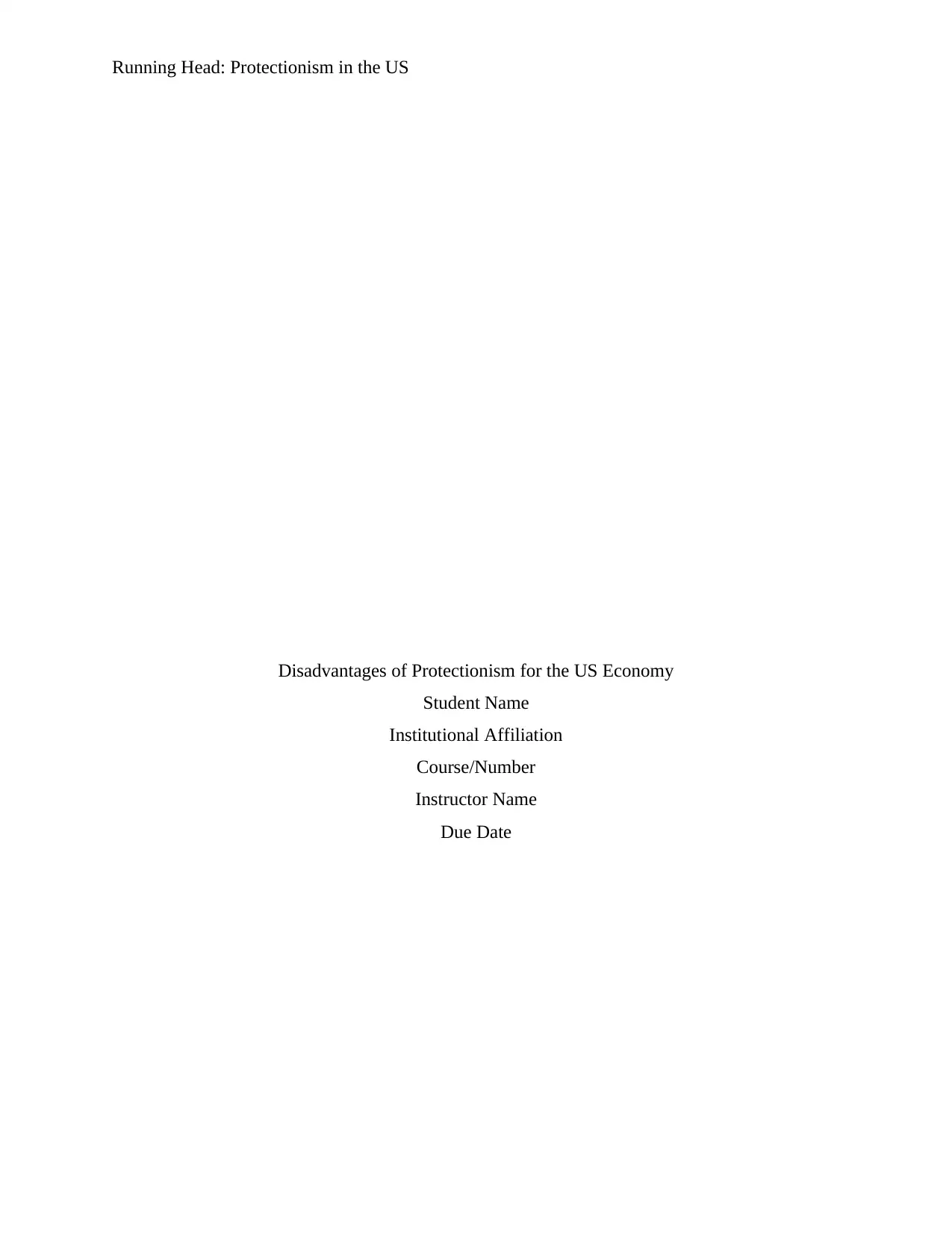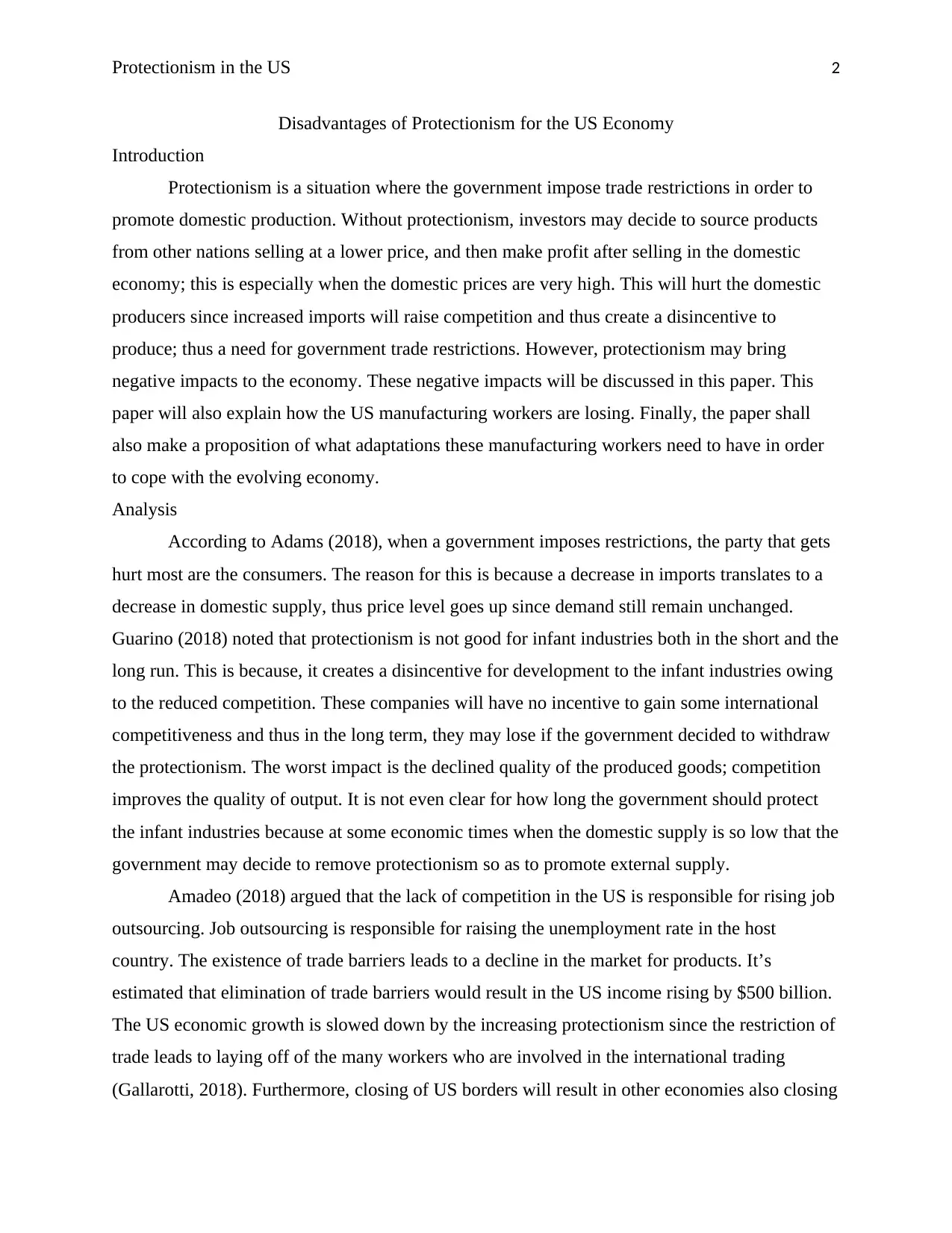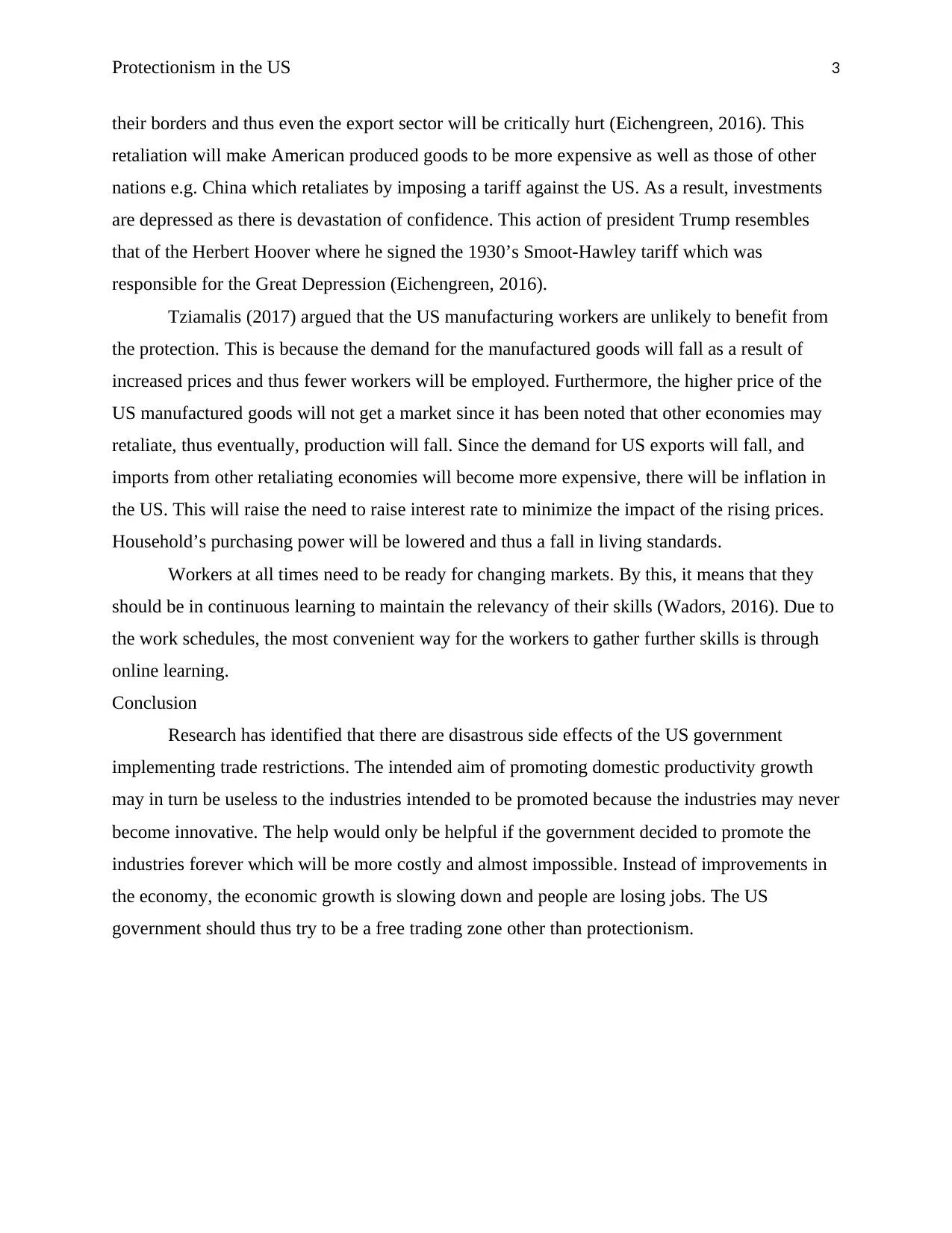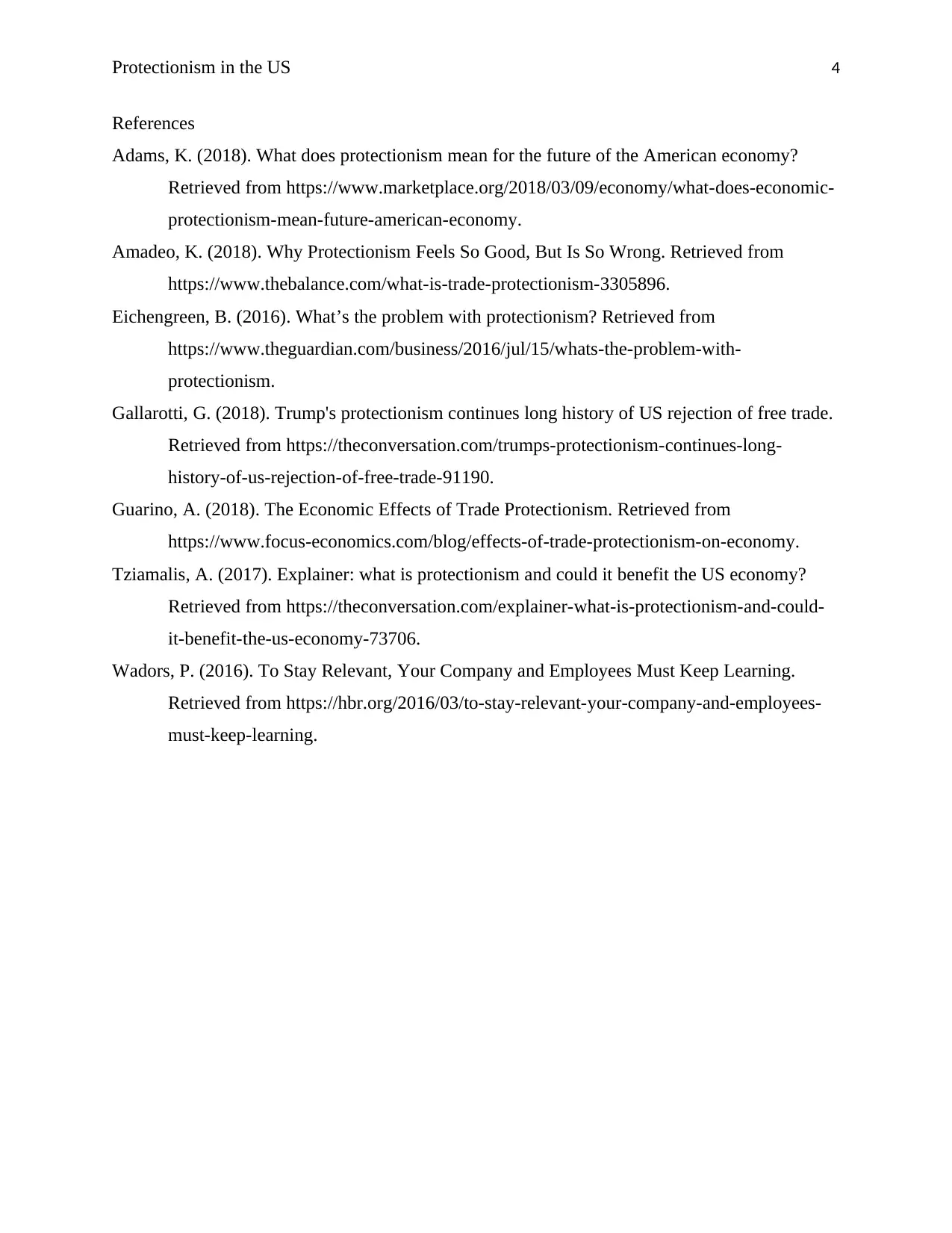Analyzing the Disadvantages of Protectionism for the US Economy
VerifiedAdded on 2023/06/04
|4
|1067
|405
Essay
AI Summary
This essay examines the detrimental effects of protectionism on the US economy. It highlights how trade restrictions, intended to boost domestic production, can harm consumers through increased prices and reduced supply. The paper discusses the negative impacts on infant industries, hindering their development by reducing competition. It also explores the link between protectionism and job outsourcing, leading to higher unemployment rates. The essay argues that the lack of competition and trade barriers slow down US economic growth, potentially costing the economy billions of dollars. It further analyzes how protectionist measures can trigger retaliatory actions from other countries, making American goods more expensive and leading to inflation. The paper also emphasizes the importance of continuous learning and adaptation for manufacturing workers to remain relevant in the changing economic landscape. The conclusion reinforces the need for the US government to embrace free trade rather than protectionist policies to foster economic growth and stability.

Running Head: Protectionism in the US
Disadvantages of Protectionism for the US Economy
Student Name
Institutional Affiliation
Course/Number
Instructor Name
Due Date
Disadvantages of Protectionism for the US Economy
Student Name
Institutional Affiliation
Course/Number
Instructor Name
Due Date
Paraphrase This Document
Need a fresh take? Get an instant paraphrase of this document with our AI Paraphraser

Protectionism in the US 2
Disadvantages of Protectionism for the US Economy
Introduction
Protectionism is a situation where the government impose trade restrictions in order to
promote domestic production. Without protectionism, investors may decide to source products
from other nations selling at a lower price, and then make profit after selling in the domestic
economy; this is especially when the domestic prices are very high. This will hurt the domestic
producers since increased imports will raise competition and thus create a disincentive to
produce; thus a need for government trade restrictions. However, protectionism may bring
negative impacts to the economy. These negative impacts will be discussed in this paper. This
paper will also explain how the US manufacturing workers are losing. Finally, the paper shall
also make a proposition of what adaptations these manufacturing workers need to have in order
to cope with the evolving economy.
Analysis
According to Adams (2018), when a government imposes restrictions, the party that gets
hurt most are the consumers. The reason for this is because a decrease in imports translates to a
decrease in domestic supply, thus price level goes up since demand still remain unchanged.
Guarino (2018) noted that protectionism is not good for infant industries both in the short and the
long run. This is because, it creates a disincentive for development to the infant industries owing
to the reduced competition. These companies will have no incentive to gain some international
competitiveness and thus in the long term, they may lose if the government decided to withdraw
the protectionism. The worst impact is the declined quality of the produced goods; competition
improves the quality of output. It is not even clear for how long the government should protect
the infant industries because at some economic times when the domestic supply is so low that the
government may decide to remove protectionism so as to promote external supply.
Amadeo (2018) argued that the lack of competition in the US is responsible for rising job
outsourcing. Job outsourcing is responsible for raising the unemployment rate in the host
country. The existence of trade barriers leads to a decline in the market for products. It’s
estimated that elimination of trade barriers would result in the US income rising by $500 billion.
The US economic growth is slowed down by the increasing protectionism since the restriction of
trade leads to laying off of the many workers who are involved in the international trading
(Gallarotti, 2018). Furthermore, closing of US borders will result in other economies also closing
Disadvantages of Protectionism for the US Economy
Introduction
Protectionism is a situation where the government impose trade restrictions in order to
promote domestic production. Without protectionism, investors may decide to source products
from other nations selling at a lower price, and then make profit after selling in the domestic
economy; this is especially when the domestic prices are very high. This will hurt the domestic
producers since increased imports will raise competition and thus create a disincentive to
produce; thus a need for government trade restrictions. However, protectionism may bring
negative impacts to the economy. These negative impacts will be discussed in this paper. This
paper will also explain how the US manufacturing workers are losing. Finally, the paper shall
also make a proposition of what adaptations these manufacturing workers need to have in order
to cope with the evolving economy.
Analysis
According to Adams (2018), when a government imposes restrictions, the party that gets
hurt most are the consumers. The reason for this is because a decrease in imports translates to a
decrease in domestic supply, thus price level goes up since demand still remain unchanged.
Guarino (2018) noted that protectionism is not good for infant industries both in the short and the
long run. This is because, it creates a disincentive for development to the infant industries owing
to the reduced competition. These companies will have no incentive to gain some international
competitiveness and thus in the long term, they may lose if the government decided to withdraw
the protectionism. The worst impact is the declined quality of the produced goods; competition
improves the quality of output. It is not even clear for how long the government should protect
the infant industries because at some economic times when the domestic supply is so low that the
government may decide to remove protectionism so as to promote external supply.
Amadeo (2018) argued that the lack of competition in the US is responsible for rising job
outsourcing. Job outsourcing is responsible for raising the unemployment rate in the host
country. The existence of trade barriers leads to a decline in the market for products. It’s
estimated that elimination of trade barriers would result in the US income rising by $500 billion.
The US economic growth is slowed down by the increasing protectionism since the restriction of
trade leads to laying off of the many workers who are involved in the international trading
(Gallarotti, 2018). Furthermore, closing of US borders will result in other economies also closing

Protectionism in the US 3
their borders and thus even the export sector will be critically hurt (Eichengreen, 2016). This
retaliation will make American produced goods to be more expensive as well as those of other
nations e.g. China which retaliates by imposing a tariff against the US. As a result, investments
are depressed as there is devastation of confidence. This action of president Trump resembles
that of the Herbert Hoover where he signed the 1930’s Smoot-Hawley tariff which was
responsible for the Great Depression (Eichengreen, 2016).
Tziamalis (2017) argued that the US manufacturing workers are unlikely to benefit from
the protection. This is because the demand for the manufactured goods will fall as a result of
increased prices and thus fewer workers will be employed. Furthermore, the higher price of the
US manufactured goods will not get a market since it has been noted that other economies may
retaliate, thus eventually, production will fall. Since the demand for US exports will fall, and
imports from other retaliating economies will become more expensive, there will be inflation in
the US. This will raise the need to raise interest rate to minimize the impact of the rising prices.
Household’s purchasing power will be lowered and thus a fall in living standards.
Workers at all times need to be ready for changing markets. By this, it means that they
should be in continuous learning to maintain the relevancy of their skills (Wadors, 2016). Due to
the work schedules, the most convenient way for the workers to gather further skills is through
online learning.
Conclusion
Research has identified that there are disastrous side effects of the US government
implementing trade restrictions. The intended aim of promoting domestic productivity growth
may in turn be useless to the industries intended to be promoted because the industries may never
become innovative. The help would only be helpful if the government decided to promote the
industries forever which will be more costly and almost impossible. Instead of improvements in
the economy, the economic growth is slowing down and people are losing jobs. The US
government should thus try to be a free trading zone other than protectionism.
their borders and thus even the export sector will be critically hurt (Eichengreen, 2016). This
retaliation will make American produced goods to be more expensive as well as those of other
nations e.g. China which retaliates by imposing a tariff against the US. As a result, investments
are depressed as there is devastation of confidence. This action of president Trump resembles
that of the Herbert Hoover where he signed the 1930’s Smoot-Hawley tariff which was
responsible for the Great Depression (Eichengreen, 2016).
Tziamalis (2017) argued that the US manufacturing workers are unlikely to benefit from
the protection. This is because the demand for the manufactured goods will fall as a result of
increased prices and thus fewer workers will be employed. Furthermore, the higher price of the
US manufactured goods will not get a market since it has been noted that other economies may
retaliate, thus eventually, production will fall. Since the demand for US exports will fall, and
imports from other retaliating economies will become more expensive, there will be inflation in
the US. This will raise the need to raise interest rate to minimize the impact of the rising prices.
Household’s purchasing power will be lowered and thus a fall in living standards.
Workers at all times need to be ready for changing markets. By this, it means that they
should be in continuous learning to maintain the relevancy of their skills (Wadors, 2016). Due to
the work schedules, the most convenient way for the workers to gather further skills is through
online learning.
Conclusion
Research has identified that there are disastrous side effects of the US government
implementing trade restrictions. The intended aim of promoting domestic productivity growth
may in turn be useless to the industries intended to be promoted because the industries may never
become innovative. The help would only be helpful if the government decided to promote the
industries forever which will be more costly and almost impossible. Instead of improvements in
the economy, the economic growth is slowing down and people are losing jobs. The US
government should thus try to be a free trading zone other than protectionism.
⊘ This is a preview!⊘
Do you want full access?
Subscribe today to unlock all pages.

Trusted by 1+ million students worldwide

Protectionism in the US 4
References
Adams, K. (2018). What does protectionism mean for the future of the American economy?
Retrieved from https://www.marketplace.org/2018/03/09/economy/what-does-economic-
protectionism-mean-future-american-economy.
Amadeo, K. (2018). Why Protectionism Feels So Good, But Is So Wrong. Retrieved from
https://www.thebalance.com/what-is-trade-protectionism-3305896.
Eichengreen, B. (2016). What’s the problem with protectionism? Retrieved from
https://www.theguardian.com/business/2016/jul/15/whats-the-problem-with-
protectionism.
Gallarotti, G. (2018). Trump's protectionism continues long history of US rejection of free trade.
Retrieved from https://theconversation.com/trumps-protectionism-continues-long-
history-of-us-rejection-of-free-trade-91190.
Guarino, A. (2018). The Economic Effects of Trade Protectionism. Retrieved from
https://www.focus-economics.com/blog/effects-of-trade-protectionism-on-economy.
Tziamalis, A. (2017). Explainer: what is protectionism and could it benefit the US economy?
Retrieved from https://theconversation.com/explainer-what-is-protectionism-and-could-
it-benefit-the-us-economy-73706.
Wadors, P. (2016). To Stay Relevant, Your Company and Employees Must Keep Learning.
Retrieved from https://hbr.org/2016/03/to-stay-relevant-your-company-and-employees-
must-keep-learning.
References
Adams, K. (2018). What does protectionism mean for the future of the American economy?
Retrieved from https://www.marketplace.org/2018/03/09/economy/what-does-economic-
protectionism-mean-future-american-economy.
Amadeo, K. (2018). Why Protectionism Feels So Good, But Is So Wrong. Retrieved from
https://www.thebalance.com/what-is-trade-protectionism-3305896.
Eichengreen, B. (2016). What’s the problem with protectionism? Retrieved from
https://www.theguardian.com/business/2016/jul/15/whats-the-problem-with-
protectionism.
Gallarotti, G. (2018). Trump's protectionism continues long history of US rejection of free trade.
Retrieved from https://theconversation.com/trumps-protectionism-continues-long-
history-of-us-rejection-of-free-trade-91190.
Guarino, A. (2018). The Economic Effects of Trade Protectionism. Retrieved from
https://www.focus-economics.com/blog/effects-of-trade-protectionism-on-economy.
Tziamalis, A. (2017). Explainer: what is protectionism and could it benefit the US economy?
Retrieved from https://theconversation.com/explainer-what-is-protectionism-and-could-
it-benefit-the-us-economy-73706.
Wadors, P. (2016). To Stay Relevant, Your Company and Employees Must Keep Learning.
Retrieved from https://hbr.org/2016/03/to-stay-relevant-your-company-and-employees-
must-keep-learning.
1 out of 4
Related Documents
Your All-in-One AI-Powered Toolkit for Academic Success.
+13062052269
info@desklib.com
Available 24*7 on WhatsApp / Email
![[object Object]](/_next/static/media/star-bottom.7253800d.svg)
Unlock your academic potential
Copyright © 2020–2025 A2Z Services. All Rights Reserved. Developed and managed by ZUCOL.



